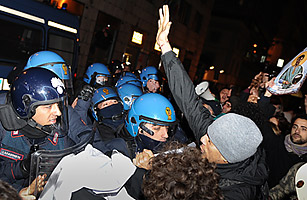
Xenophobes in homogenous European countries often complain that immigrants will erase their most precious cultural norms. The race riots in southern Italy last weekend may be one indicator that change is inevitable, as African immigrants who don’t live by the country’s infamous omert code of silence violently protested against the powerful Mafia clans that control their lives, says Roberto Saviano, author of Gomorrah, an anti-Mob book that earned him both critical praise and a 24-hour police guard. Saviano — who reported from within the Camorra, Italy’s biggest Mafia clan with a global reach into fashion, real estate, waste disposal and drugs — says the rioters are among the hundreds of thousands of immigrants caught up in a brutal cheap-labor system the Mafia runs for legitimate businesses from Milan to Naples.
The riots in Rosarno, which reportedly began after three Italian teenagers fired air rifles at two African immigrants, unsettled a nation that prides itself on its bella figura — the beautiful image. About 2,500 migrants live in the Rosarno valley in the southern Calabria region, moving with the seasonal agricultural jobs. Many have political asylum or are otherwise legally in Italy, but legal or not, the migrants are managed by a Mafia-run employment system, the caporalato, that operates like a 21st century chain gang. Saviano says that those who object to low wages or poor working conditions are simply eliminated — and not just by a pink slip. “It’s a military system,” Saviano tells TIME in Rome as one of the plainclothes cops guarding him stands nearby. “The farm and factory owners employ the Mafia caporali to bring the workers. The immigrants wait on the roads, the caporali pick them up and take them to the work. If they complain, they get killed.”
The immigrants arrive in Italy from impoverished African or Eastern European countries and find themselves trapped in a system in which they work 10- to 14-hour days for about $3 an hour. They live in tents or shacks pitched inside abandoned buildings, without appliances, plumbing or health care. Italian society supports the system by keeping the immigrants on its margins. Services are few and far between, mainly provided by religious organizations. Non-Italian police are rarely seen, and only one nonwhite serves in Parliament. Many immigrants simply do not report crimes against them. Disappearances are frequent — the Polish government is still looking for more than 100 Polish migrants who vanished from the tomato farms of Puglia in 2006, some of whom are believed to have been killed.
Ironically, though, southern Italy’s crime clans seem like a welcome wagon for the immigrants at the beginning, providing a deceptively accepting community for newcomers. “For the Mafia to keep them as low-priced labor, they create this atmosphere of tolerance,” Saviano says. “They actually live better down there than in Milan. They are treated and paid like slaves, but the human relationships are warmer than those you would find in Milan. Africans say the Italian girls look them in the eyes in Calabria, while in the north they wouldn’t.”
Still, as the Rosarno riots illustrate, the immigrants are far from accepted by most Italians. Shootings like the ones that sparked the unrest are not uncommon. “We used to learn how to use our guns down there by shooting at dogs,” says Saviano, who was brought up in the Naples area. “Now the 14-year-olds shoot at immigrants. It can look like kids fooling around, but it’s not; it’s target practice.” The town’s African population responded by burning cars and smashing shop windows, prompting retaliatory attacks by white residents. It was the fourth outbreak of violence in the region in recent years. Six Africans died two years ago in fighting in the coastal town of Castel Volturno.
While the shootings were the apparent spark of the riots, the global economic downturn was a more distant cause. With budgets tightening, the E.U. cut its aid to southern Italian farmers, reducing the need for manual labor. “The Mafia wants to earn the same profits, and the workers are becoming a burden,” Saviano says. Authorities have also turned a blind eye to their problems. Rather than increase social services or workplace regulations, Prime Minister Silvio Berlusconi’s administration has taken an increasingly popular anti-immigrant stance. About 1,000 of the African migrants in Rosarno were carted off to detention centers after the violence — some at their own request, the government says. Interior Minister Roberto Maroni, a member of the anti-immigrant Northern League party, said that “too much tolerance” had caused the unrest.
Saviano disagrees. “It’s obvious they have let the Mafia freely do with the immigrants as they wish,” he says. “When they undergo injustice, the immigrants have enormous difficulties speaking up about it, even when they have been abused by their own community.” He adds, however, that this may be starting to change. “They are not like Italian workers, who will just leave if they don’t like it. They protest because these jobs are the best situation they can have,” he says. “As a southern Italian, I would tell these people, ‘Stay. Please don’t leave us alone with the Mafia.'”
— With reporting by Giulia Alagna
Read “An Italian Town’s White Christmas.”
See pictures of Italians in America.